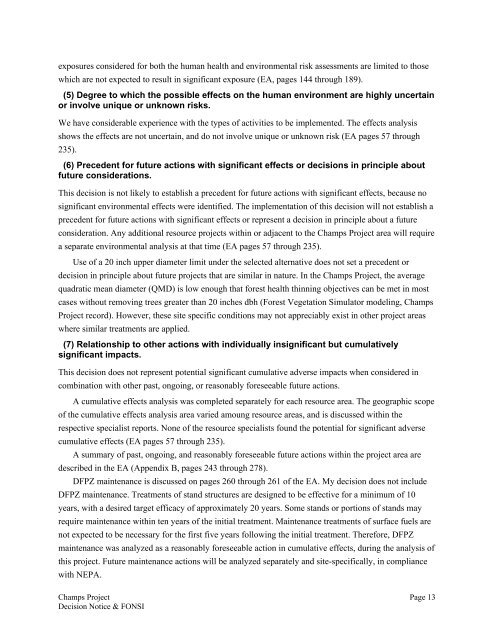Champs Project
Champs Project
Champs Project
You also want an ePaper? Increase the reach of your titles
YUMPU automatically turns print PDFs into web optimized ePapers that Google loves.
exposures considered for both the human health and environmental risk assessments are limited to those<br />
which are not expected to result in significant exposure (EA, pages 144 through 189).<br />
(5) Degree to which the possible effects on the human environment are highly uncertain<br />
or involve unique or unknown risks.<br />
We have considerable experience with the types of activities to be implemented. The effects analysis<br />
shows the effects are not uncertain, and do not involve unique or unknown risk (EA pages 57 through<br />
235).<br />
(6) Precedent for future actions with significant effects or decisions in principle about<br />
future considerations.<br />
This decision is not likely to establish a precedent for future actions with significant effects, because no<br />
significant environmental effects were identified. The implementation of this decision will not establish a<br />
precedent for future actions with significant effects or represent a decision in principle about a future<br />
consideration. Any additional resource projects within or adjacent to the <strong>Champs</strong> <strong>Project</strong> area will require<br />
a separate environmental analysis at that time (EA pages 57 through 235).<br />
Use of a 20 inch upper diameter limit under the selected alternative does not set a precedent or<br />
decision in principle about future projects that are similar in nature. In the <strong>Champs</strong> <strong>Project</strong>, the average<br />
quadratic mean diameter (QMD) is low enough that forest health thinning objectives can be met in most<br />
cases without removing trees greater than 20 inches dbh (Forest Vegetation Simulator modeling, <strong>Champs</strong><br />
<strong>Project</strong> record). However, these site specific conditions may not appreciably exist in other project areas<br />
where similar treatments are applied.<br />
(7) Relationship to other actions with individually insignificant but cumulatively<br />
significant impacts.<br />
This decision does not represent potential significant cumulative adverse impacts when considered in<br />
combination with other past, ongoing, or reasonably foreseeable future actions.<br />
A cumulative effects analysis was completed separately for each resource area. The geographic scope<br />
of the cumulative effects analysis area varied amoung resource areas, and is discussed within the<br />
respective specialist reports. None of the resource specialists found the potential for significant adverse<br />
cumulative effects (EA pages 57 through 235).<br />
A summary of past, ongoing, and reasonably foreseeable future actions within the project area are<br />
described in the EA (Appendix B, pages 243 through 278).<br />
DFPZ maintenance is discussed on pages 260 through 261 of the EA. My decision does not include<br />
DFPZ maintenance. Treatments of stand structures are designed to be effective for a minimum of 10<br />
years, with a desired target efficacy of approximately 20 years. Some stands or portions of stands may<br />
require maintenance within ten years of the initial treatment. Maintenance treatments of surface fuels are<br />
not expected to be necessary for the first five years following the initial treatment. Therefore, DFPZ<br />
maintenance was analyzed as a reasonably foreseeable action in cumulative effects, during the analysis of<br />
this project. Future maintenance actions will be analyzed separately and site-specifically, in compliance<br />
with NEPA.<br />
<strong>Champs</strong> <strong>Project</strong> Page 13<br />
Decision Notice & FONSI
















